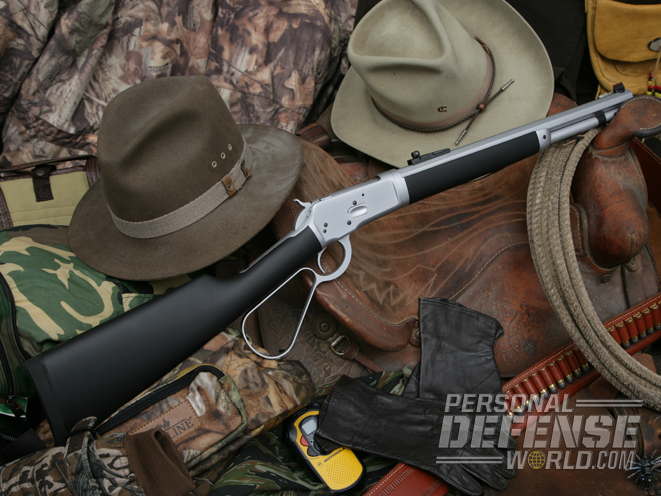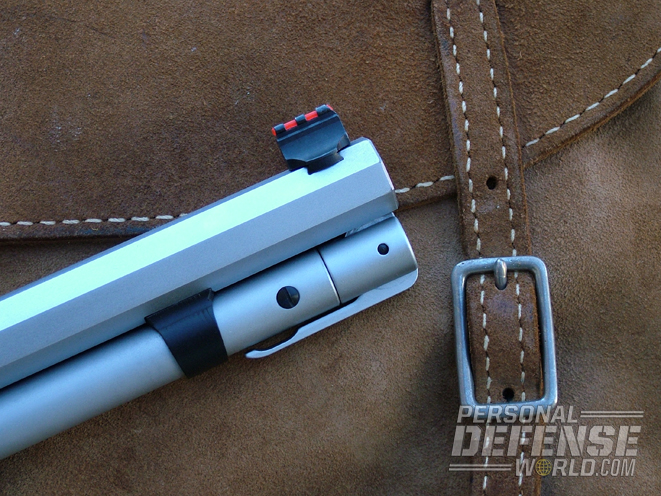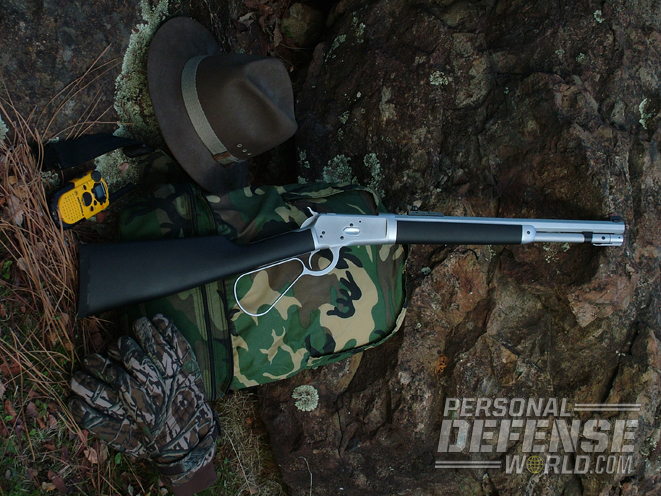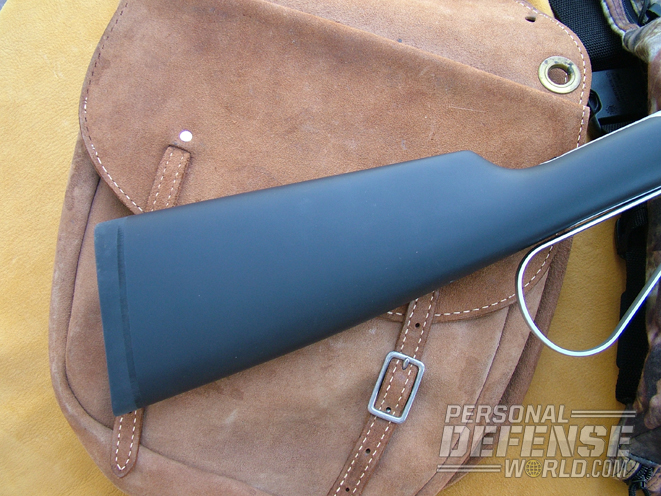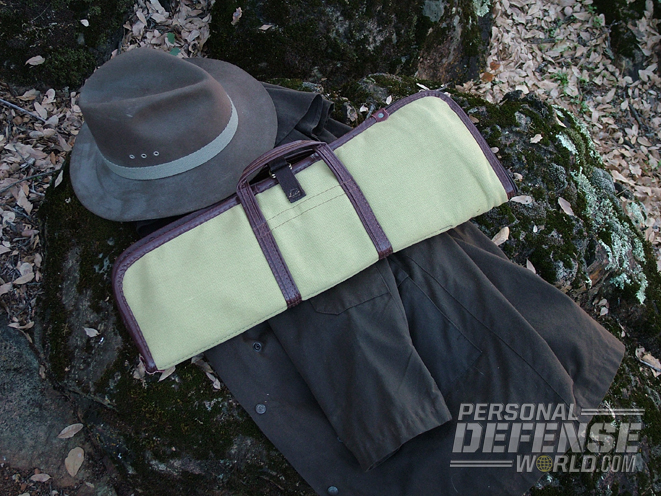I got my first lever action when I was 12. I hope my dad didn’t see the disappointment in my face when I opened that carbine-sized box from under the Christmas tree—expecting to find the Winchester Model ’94 I’d asked for—and instead found a Marlin Model 336 or whatever the Sears model designation for that gun was. While I eventually learned to really like that Marlin, I never lost the desire to own a genuine Winchester. That was many, many years ago, and my gun safe today holds several guns with lever actions, the majority of which are either true Winchesters or replicas thereof.
Of the many I own and have owned, I’ve never had either a truly short-barreled one (usually referred to as a “baby” or “trapper” model) or one with a takedown feature allowing it to be broken in half for easy transport and storage. Well, thanks to Taylor’s & Co. and Chiappa Firearms, I get to experience both of these features in one gun. They call it the “Alaskan,” and it’s truly a nifty and practical little firearm.
History of the 1892
Advertisement — Continue Reading Below
The Winchester Model 1892 is arguably the slickest and handsomest lever gun ever devised. Those of you who are familiar with early Winchester model numbers will immediately know that the Model 1892 lever gun was introduced by Winchester in 1892. It was the second lever-operated repeating firearm sold to Winchester by its designer, John Moses Browning, and was essentially a scaled-down version of the first rifle he’d sold them, which Winchester had designated the Model 1886.
Whereas the Model 1886 was designed to fire the big-bore blackpowder cartridges of the day, like the .45-70 and .45-90, the sleeker, svelte little Model 1892 was designed around Winchester’s shorter, dual-purpose cartridges like the .44-40, .38-40 and .32-20, which could be fired in both handguns as well as light rifles and carbines.
Back in those early years, Winchester was very amenable to building a rifle pretty much any way the customer wanted. You could have longer barrels, shorter barrels, heavy or lightweight barrels, custom wood, custom finishes, a myriad of different sighting options, carving, engraving, checkering, short magazines, full-length magazines, shotgun butts, rifle butts, carbine butts, set triggers—and beginning around 1894 a takedown system allowing separation of the rifle or carbine at the juncture of its receiver and barrel/forearm assembly, making the firearm much more compact for storage or travel. You could even order a separate front end in a different caliber (if the two rounds shared the same case head) or configuration, if you wanted. In the Model 1892, barrels as short as 14 inches were offered.
Advertisement — Continue Reading Below
Gun Details
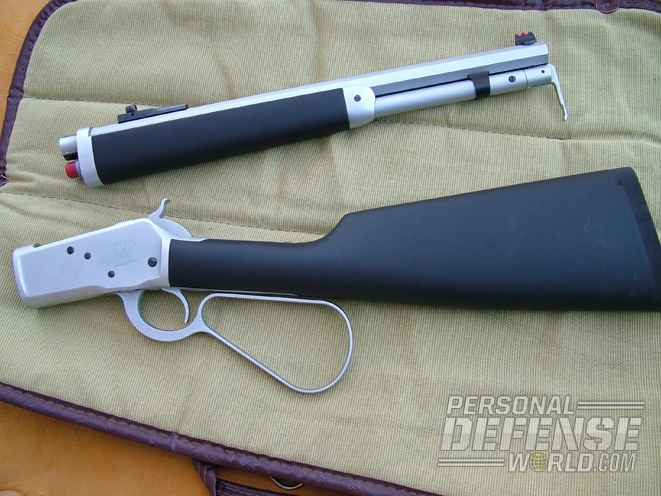
Released exclusively by Taylor’s & Co. of Winchester, Virginia, in late 2012, the Alaskan is a modernized version of the Model 1892 made by Chiappa Firearms in Italy. It features not only the handiness and compactness of a short-barreled carbine, but the portability and storability
of a takedown long gun as well. But that’s not all.
“My test Alaskan was a .45 Colt, of which I’m told less than 200 were imported…”
Let’s start with its barrel. The Alaskan is offered in two lengths: a 20-inch-barreled version (a standard length for the 1892 carbine) and one with a much handier 16-inch tube. My test gun wore the shorter barrel. It is octagonal in profile, measuring 0.31 inches across each flat, and tapers slightly from the receiver to the muzzle. The stoutness of this short tube provides just the right amount of weight out front for easy, well-balanced handling.
Advertisement — Continue Reading Below
Initially offered chambered either in .45 Colt, .44 Mag or .357 Mag, the .45 Colt chambering is slated to be discontinued when existing supplies are exhausted, with future guns offered only in the latter two magnum calibers after that. My test Alaskan was a .45 Colt, of which I’m told less than 200 were imported. The full-length magazine on my short-barreled loaner was reported to hold seven rounds of ammunition in reserve, but this example easily accommodated eight rounds in its tube, making it a nine-shooter with one up its spout. The longer 20-inch-barreled versions of the Alaskan are designed to carry 10 extra cartridges in their magazines regardless of chambering.
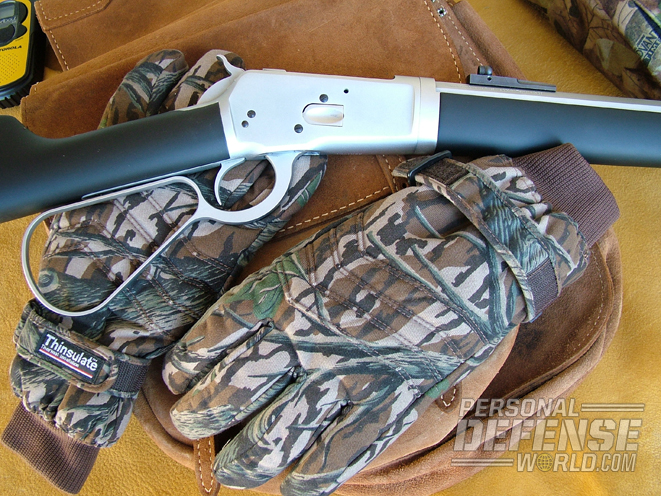
In keeping with its intended role as a rough-country hunting, backpacking and survival weapon, the majority of the Alaskan’s metal surfaces have been hard-chrome plated for rust resistance and durability. Only a few screws, its magazine hanger, its sights and a few internal parts remain unplated, and these darkened parts contrast nicely with the rest of the Alaskan’s gray, satiny exterior. Proper metal preparation prior to finishing was evident on all of the Alaskan’s surfaces, with all flats flat, all screw holes round and all other proper contours present and absent of milling or machining marks.
Advertisement — Continue Reading Below
The buttstock and forend of the Alaskan are unique in that they are fabricated out of hardwood and covered with a black rubberized overmolding that Chiappa calls its “Soft Touch” finish. It is soft and slightly tacky to the touch, and it goes along quite smartly with the rest of the Alaskan’s exterior. Only time and use will determine its long-term durability. I didn’t think Taylor’s would appreciate my banging its test sample around to check its ruggedness, but the company told me that this coating is applied by Chiappa in Italy and is bonded directly to the wood. The length of pull on the Alaskan measured 14.06 inches, ending in a well-fitted, 0.75-inch, rubber recoil pad. The rubber-to-metal fit was well executed, with no gaps or overhangs present.
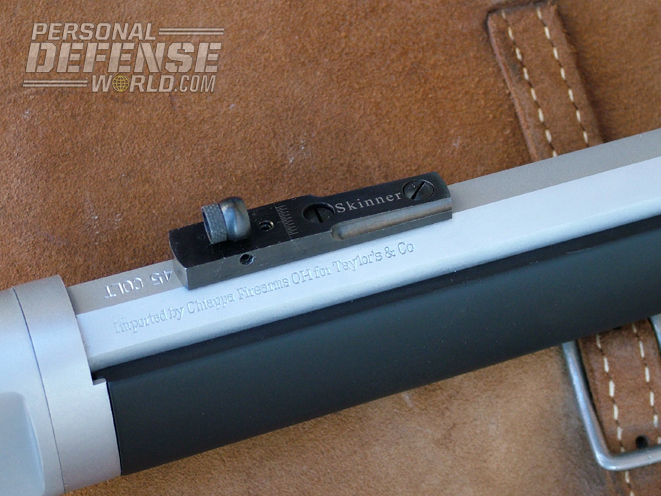
Now let’s talk about the Alaskan’s sights. I cut my teeth on peep sights. My first two deer rifles wore them, and in my younger years I always felt comfortable hunting with them and never felt handicapped that my rifles weren’t wearing the latest in optics. So, I was a little skeptical when I first saw the barrel-mounted peep sight setup on the Alaskan, which puts the little hole you look through so very far away from your eye. The theory, as I’ve come to understand it, behind the tang or receiver-mounted peep sight was that you looked through the aperture like it wasn’t there and focused on the front sight, and that your eye naturally found the center of the hole, making shots precise. I wasn’t sure just how that was going to work with this rifle’s “scout-like” peep setup, with the tiny hole being located so far down its barrel.
“Whether your Alaskan wears a 16- or 20-inch barrel, when disassembled it will now fit into a short pouch or survival bag for easy stowing in your backpack or SUV…”
Andy Larsson of Skinner Sights, located in St. Ignatius, Montana, makes the rear sight assembly that comes on the Alaskan. It’s a very attractive and precisely machined sight made from carbon steel, finished in black oxide, and it’s fully adjustable for both windage and elevation. It comes with a 0.096-inch aperture; however, apertures with other hole sizes are available to suit one’s eye or shooting style. Being barrel-mounted put the aperture of that Skinner Sight some 10 inches from my eye, but time spent with it at the range has proven—especially when paired with the red fiber-optic front sight that came on the Alaskan—that it works. Although I’m getting a little long in the tooth and my eyes aren’t what they used to be, the sights on the Alaskan proved to be quite effective and quick to acquire. And, since both the front and rear sights are barrel-mounted, the system stays sighted in regardless of how many times the gun is disassembled. With this barrel-mounted peep system you don’t have to worry where the front sight is in relation to the rear notch (as with your conventional buckhorn rear sight); you just look through the aperture and put the front sight on the target.
Advertisement — Continue Reading Below
The Skinner rear sighting system mounts to the Alaskan using two of four pre-drilled and tapped holes found on the octagonal barrel’s top flat. Removal of the Skinner sight provides access to all four holes for the mounting of Weaver-type 61M bases to install a scout scope setup—another good sighting system for this handy little long gun. Skinner Sights makes several variations of its sighting system for mounting on almost any long gun and some handguns.
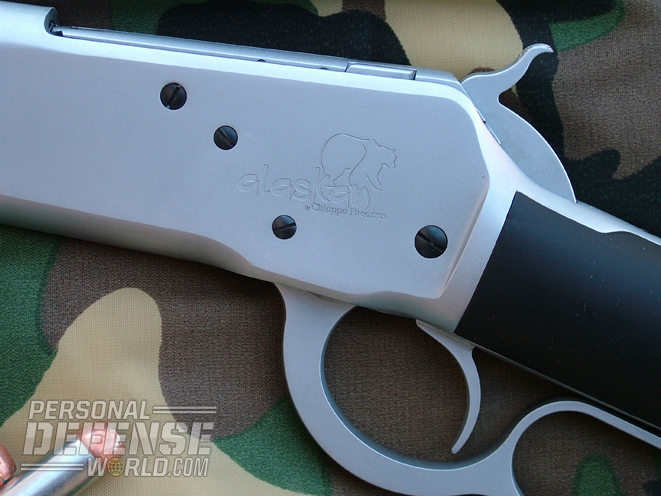
Ever since I first saw John Wayne and Chuck Connors wield their big-looped Winchesters, I wanted one. It wasn’t until pretty recently that I got to play with a couple current renditions of these carbines and found that although they looked super cool, they weren’t all that spiffy to operate. As fast as Lucas McCain was with his ’92, and as cool as it looked when Rooster twirled his carbine when charging the Ned Pepper gang, I found those gargantuan loops pretty awkward and much slower to operate over a conventional-shaped lever. That being said, the slightly oversized lever found on the Alaskan, although still providing a touch of panache to the gun, does serve to provide some extra room for use with heavily gloved hands while still being easy to use. And, I have to admit it does give the Alaskan a distinct and unique profile.
Advertisement — Continue Reading Below
With an overall length of 34.25 inches, the 16-inch-barreled Alaskan is pretty handy “as is” (as is the 20-inch barreled version at 38 inches, for that matter), but when disassembled into its two parts, with the longest piece measuring less than 20 inches, it becomes pretty portable indeed. The takedown system found on the Alaskan is pure Winchester. To disassemble, locate the magazine disassembly lever at the front or muzzle end of the magazine tube. Lift this lever so that it is perpendicular to the barrel and then use it to unscrew the mag tube in a counterclockwise direction until free to move up and down. When completely unscrewed, open the finger lever so that the bolt’s extractor is withdrawn from its notch in the barrel extension (failure to do this will result in damage to the extractor and/or barrel extension). Now, holding the stock in one hand and the forearm in the other, twist or rotate the forearm in a clockwise direction so that it moves to a position 90 degrees (one-quarter turn) to the receiver. Interrupted threads allow the barrel and receiver to separate at this point. To reassemble, repeat this process in the reverse order. Whether your Alaskan wears a 16- or 20-inch barrel, when disassembled it will now fit into a short pouch or survival bag for easy stowing in your backpack or SUV.
Range Time
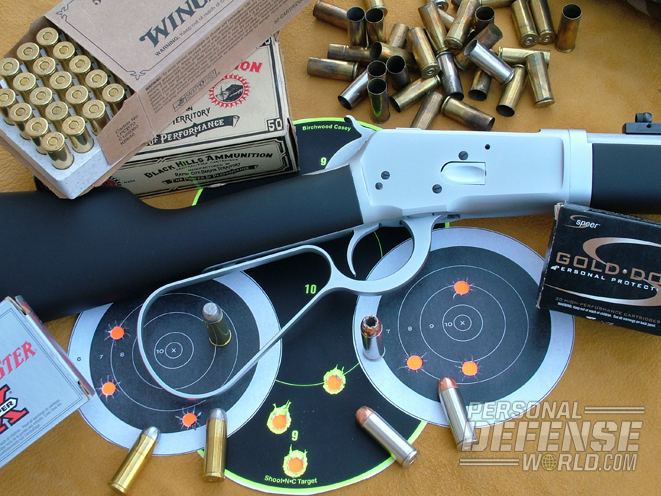
Advertisement — Continue Reading Below
To see how well the Alaskan would shoot, I put it on paper from 50 yards out with four different factory .45 Colt loadings I had on hand. These consisted of two lead-bullet Cowboy loadings from Black Hills and Winchester and two jacketed-hollow-point offerings from Speer and Winchester. As you can see in the accompanying chart, this particular Alaskan really liked the 250-grain Gold Dot Hollow Points from Speer, averaging three-shot groups at just over 2 inches center to center. These exited the muzzle of this little carbine traveling right at 868 fps, producing 418 foot-pounds of energy in the process. The two lead-bullet loadings’ performance was right on the heels of the Speer loading, forming groups in the 2.5-inch range with similar velocities that measured around 850 fps. With its total weight of 6.5 pounds and its cushiony rubber buttpad, recoil when firing the Alaskan off the bench was negligible, and it functioned flawlessly during this range session. Its trigger broke crisply and without creep at 3.75 pounds of pressure and, as long as its action was worked briskly, ejected cases exited well clear of the shooter.
If you’ve been looking for an easy-packing, fast-handling, readily stowable, reasonably powered, handgun-compatible and weather-resistant lever gun, you need to check out the Taylor’s & Co. 1982 Alaskan. It’s a lot of lever gun in a small, portable package.
For more information, visit http://www.taylorsfirearms.com or call 540-722-2017.
Advertisement — Continue Reading Below
This article was originally published in the 2015 issue of GUN ANNUAL. Subscription is available in print and digital editions here.
